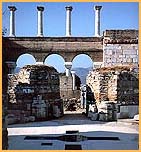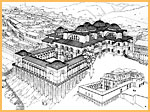|
Ephesus, an outstanding religious
city
The impressive remains of Ephesus bare witness
t o
the prosperity of the city in the Early Byzantine times. Great
buildings of all kinds were maintained, while new ones were
built: the governor's palace, impressive
porticoes, lavish
baths and extensive houses. The 600 m long Arkadiane street
(dating to the reign of
Arkadios (395-408)
connected the city centre and the port. The street was paved
with blocks of limestone and marble and had mosaic sidewalks;
at night, it was lighted by lamps. The roughly contemporary
Embolos was a pedestrian colonnaded street graced with statues
and dedications. The Street of Eutropius, also lined by a
colonnade, connected the Theatre Square with the Embolos.
The Arkadiane was rebuilt in the late fifth or early sixth
century, and adorned by Justinian with statues of the four
Evangelists on tall columns. Justinian also built a fountain
near the stadium and probably the aqueduct on the hill of
Ayasuluk. o
the prosperity of the city in the Early Byzantine times. Great
buildings of all kinds were maintained, while new ones were
built: the governor's palace, impressive
porticoes, lavish
baths and extensive houses. The 600 m long Arkadiane street
(dating to the reign of
Arkadios (395-408)
connected the city centre and the port. The street was paved
with blocks of limestone and marble and had mosaic sidewalks;
at night, it was lighted by lamps. The roughly contemporary
Embolos was a pedestrian colonnaded street graced with statues
and dedications. The Street of Eutropius, also lined by a
colonnade, connected the Theatre Square with the Embolos.
The Arkadiane was rebuilt in the late fifth or early sixth
century, and adorned by Justinian with statues of the four
Evangelists on tall columns. Justinian also built a fountain
near the stadium and probably the aqueduct on the hill of
Ayasuluk.
Early on, church building on a large scale gave Ephesus
the appearance of a Christian city. Former public buildings
were converted into churches, while several
basilicas and
chapels were erected. In the sixth century, Justinian added
a mausoleum to the complex of the Seven Sleepers, and  commissionned
the construction of the basilica of St John on the site of
an earlier cruciform timber-roof church. The huge fourth-century
basilica of the Virgin was also rebuilt twice on a smaller
scale after the sixth century. commissionned
the construction of the basilica of St John on the site of
an earlier cruciform timber-roof church. The huge fourth-century
basilica of the Virgin was also rebuilt twice on a smaller
scale after the sixth century.
The church of St John, the greatest monument of imperial
munificence in Ephesus, was centered on the
martyrion
erected over the evangelist's tomb in the fourth century on
the barren hill of Ayasoluk outside the city walls. The Justinianic
building (begun in 535/536) was a
transept basilica
with domes over the central crossing, the sanctuary, the transept
wings and the
nave, six in
all. The decision to cover the building with domes occured
once the eastern part of the church (sanctuary and transept)
had already been started. Consequently, massive ashlar pillars
intended to carry the domes had to be added at the intersection
of the nave and transept. The brick and stone walls were lined
with arcades resting on columns, and strengthened from the
ourside with buttresses. The side
aisles supported
galleries and
the
narthex gave
access to a large colonnaded
atrium
overhanging the plain of Ephesus. The
bema and high
synthronon occupied
the centre of the transept, just under the central dome and
over the presumed tomb of the evangelist. The latter was reached
by a flight of steps from the altar. A fifth-century octagonal
baptistery flanks
the church, and a domed sacristy was added next to it in the
late sixth or early seventh century. The church was paved
with mosaics of geometric design and
opus sectile,
and adorned with mosaic and frescoes. Much of the marble carving
was executed by Constantinopolitan workers, either in the
capital or in Ephesus. The bases, columns and
capitals of
the nave (the latter bearing the monograms of Justinian and
Theodora) were imported from the quarries of Proconessus,
near Constantinople. The capitals of the eastern part of the
church were made by local craftsmen according to Constantinopolitan
models. Justinian's church became a major attraction for pilgrims.
The pilgrimage facilities that sprung up around it were supplied
in water by the acqueduct built by the same emperor.
|